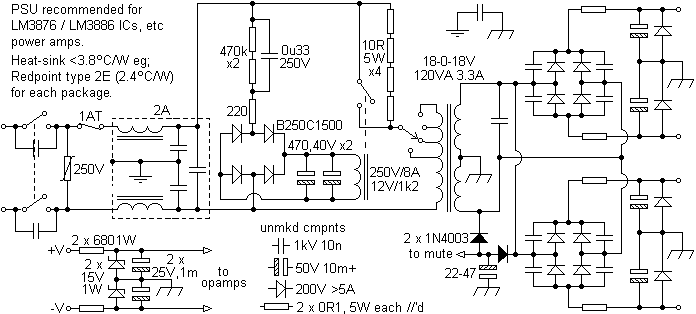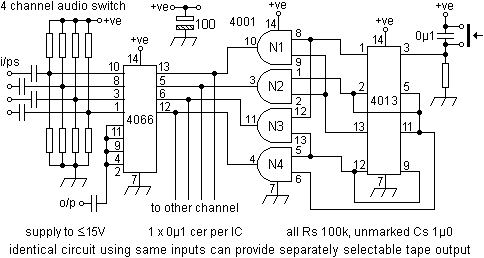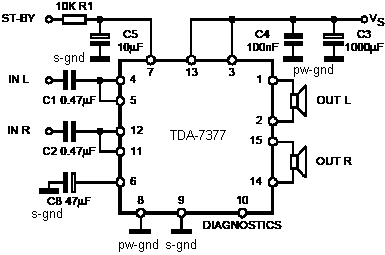Peter, your email address malfunctioned. Please try again.
ICs and modules
Wherever possible, it makes sense for a manufacturer to settle on a 'standard' design known to function satisfactorily, thus saving costs. Modules, such as the Mullard LP1162, appeared in many commercial designs whether audio or TV. A faulty amplifier could then be easily replaced with little or no diagnosis.
Early IC power amplifiers were not particularly robust, some even failing to survive the soldering process! In response to my call "One recalls Plessey ICs (3W?) being used for a Practical Electronics / Wireless stereo amplifier which sported a boltable heatsink tab at each end (anyone have a copy?)", Steve Radley has kindly come up trumps with the very detailed Plessey SL403 Application Report 'based on a series of articles written by Mr Gay (Chief Engineer, Linear Circuits) for 'Practical Electronics'', dated Jan','70, a PDF of which the author can supply on request. This design was an introduction for many, despite the logic series ICs then available, to microelectronics and the long-awaited miniaturisation that would surely follow.
The 50 thou square chip was mounted on a steel strap and an output of between 1 and, optimistically, 3W was possible.
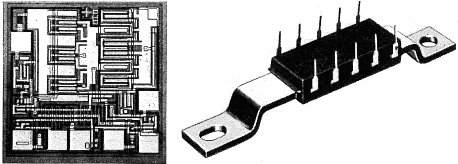
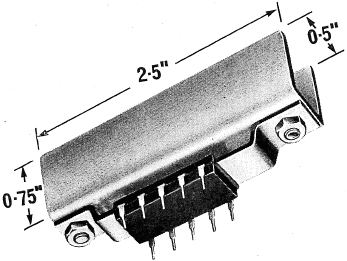
Note the wider than normal 0.2" pin pitch and that the image of the IC's boltable attributes is hand-rendered, typical of the day. Package thermal dissipation (chip to ambient) was 11°C/W. The radiator used 5 sq" of 18swg copper, aluminium, steel, etc. Plain washers between bolt-head and nut were advised, and silicon grease could 'do no harm'. With suitable holes in a PCB the IC could easily be mounted directly on to a metal enclosure (negative ground).
Internal circuit layout which included a preamplifier gain stage that could be used to provide thermal feedback for the quiescent current. The chip's non-commercial attributes belie it's high-frequency and 'defence' origins, the SL403A being a higher voltage pin-compatible version of the SL402A.
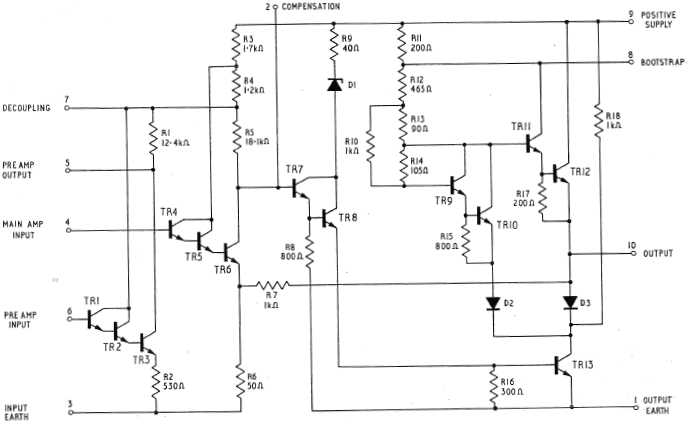
Schematic for a stereo integrated amplifier.
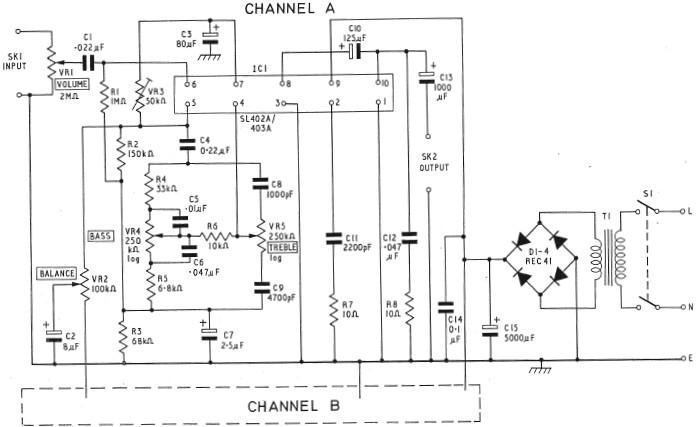
The quoted spec for the above arrangement was 15Hz to 50kHz ±3dB, distortion <1%, noise (ref 2W7) -80dB, treble +11.5dB/-15dB at 15kHz bass +10dB/-17dB at 40Hz, sensitivity 160mVrms for 2W7 output, crosstalk -40db. Supply line voltages ranged from 17V4 (quiescent) to 15V8 (both channels driven). The absolute max supply V was 24V and for operating 21V, 18V being nominal (SL402A 20, 16 and 14V respectively).
For 'hi-fi', a preamp circuit and 3-way (BMT) amplifier arrangement were suggested. These were compared favourably in terms of sonic quality to other discrete designs capable of 10W (the then new 'commercial standard', most domestic audio equipment producing about 3W or less) with 0.1% distortion. Below is the design which must represent one of the earliest examples of IC op-amps being used in a 'hi-fi' preamp.

Notable is the additional switch wafer, compared to other approaches. Below, the SL702C's internal layout which is quite simple by today's standards, although capable of a useful frequency range of 10MHz.
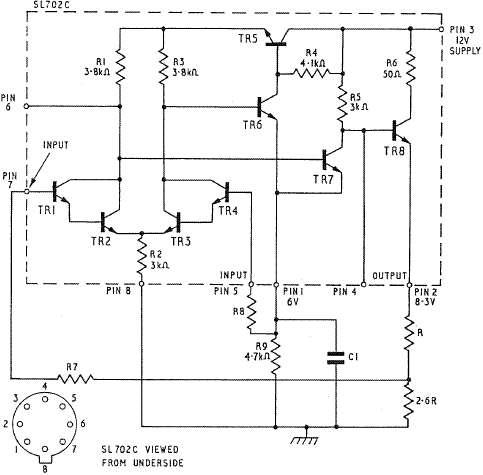
Specs were surprisingly good and would withstand comparison with modern offerings, a tape output being best taken from the top of the volume control.
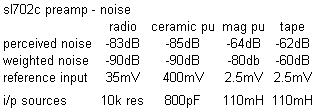
Typical of those found in PE and PW, a stripboard layout for a complete stereo preamp is shown below.

These, although not perfect, were of immense practical use to a new-comer learning how to solder. Below, the circuit diagram for the 3-way amplifier. The speaker units suggested were the Goodman's Audiom 61, Midax and Trebax, all of which were 15R.
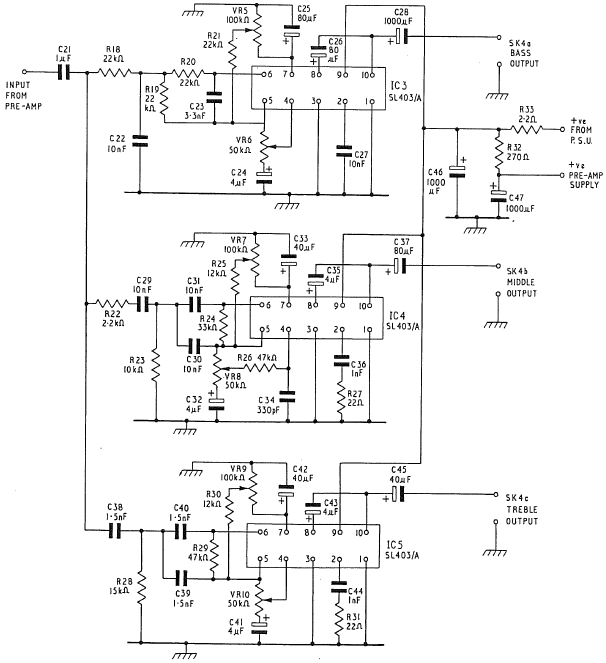
The 2R2, 1mF filter gives 12dB attenuation at 300Hz and 17dB at 500Hz, etc, of supply by-products (Trx = 2 x 6V3 in series, 5mF smoothing). The upper pots (VRs 5, 7 and 9) set the output DC, the lower ones (VRs 6, 8 and 10) the stage gain. Another stripboard layout for the above. The + terminal of C28 (bass output coupler) is shown disconnected,
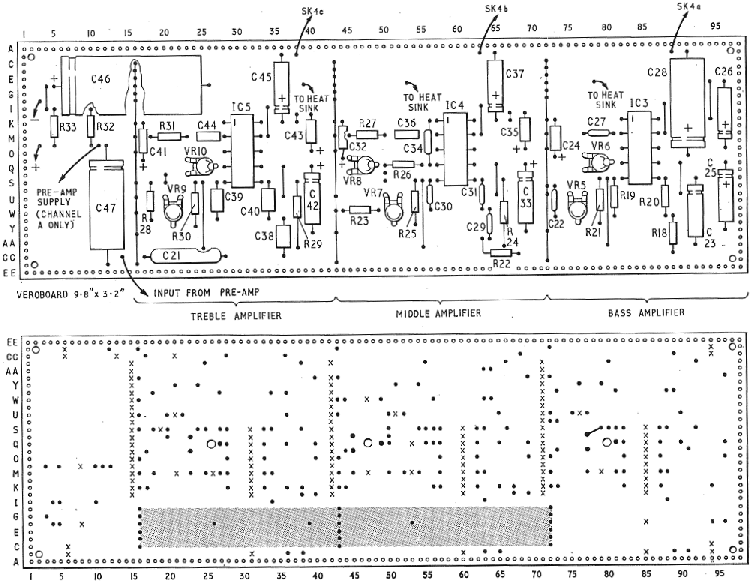
a suggested heat-sink arrangement being (cut-away intended for C46 and not C47)
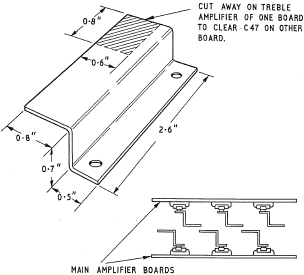
The quoted spec for the above arrangement was 3Wrms per channel into 15R, 13Hz to 100kHz ±3dB, THD at full output 0.3%, noise -90dB, treble ±15dB at 15kHz and bass ±18db at 20Hz, sensitivity - radio 35mVrms, ceramic pu 400mVrms, mag pu 2.5mVrms at 1kHz, crosstalk <40db at 1kHz.
Although costs and complexity for an amateur were higher the appeal of this approach was tangible, being 'cutting-edge', 'ahead of it's time' and sonically impressive despite the higher powers then being adopted. At the end of the application note, reference is made to 'a typical commercial Hi-Fi system' (SP25? deck, Linton type speakers) made by Britmac Electrical Co Ltd, using the SL400 series. Were there others? It is assumed that these devices were marketed as the unsuccessful Sinclair IC-10, Plessey apparently exhibiting little enthusiasm.
"The Sinclair IC was actually made by Plessey and rebranded and rerated to 12W by Sinclair. But this was none of your namby-pamby RMS Watts - more like peak power into minimum Ohms on a leap-Tuesday. The real IC rating for the Plessey SL404 (or a number something like that) was about 3W. I remember the Plessey Semiconductors rep, back in the '70s or '80s, telling me they were indebted to Sinclair for finding a real wear-out mechanism in that IC. Apparently, at high power, one of the internal substrate metallisations gradually eroded/migrated, due to high current flow, until it ruptured. This did not happen at Plessey's rated power output. Mike" (sourced by Cherukupalli Rama Murthy).Manufacturers then put similar dissipations into normal DIL packages, some with side-wings which could be soldered to the PCB or have fins clamped to them. One type was best mounted vertically to obtain the highest air-flow through it's integrated fins.
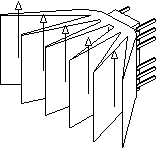
Such packages were used for amplifier circuits in TVs, many of whose PCBs were mounted vertically. Cheap record-players that mounted this type upside-down suffered the highest failure rates.
Intended for the then ('70s) popular 'home constructor' market and bearing an uncannily striking physical resemblance to the Texas Instruments SN760**N series (requests for data sheets for which have been received, are there any out there? Those below appear to match SN76013), the Sinclair Super IC-12 was one of these, the schematic for which is shown below
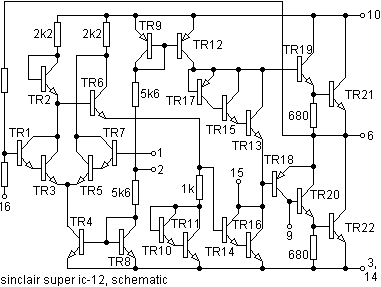
the recommended configuration being
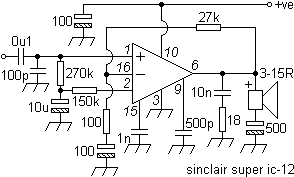

Most significant for the author, as was common at this time, is the lack of protection circuitry, current limiting, clamps, etc. Service arrangements were offered for failed assembly attempts.
A variety of 'add-on' circuits were suggested to increase versatility and were sold as kits.
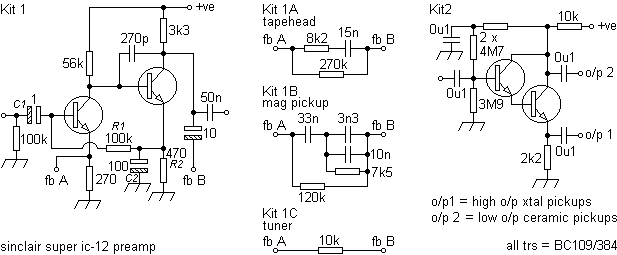
Points 'fb A' (Kit 1) could be commoned and the respective 'fb Bs' were selected via a switch paralleled with another that then switched the designated input signal. Kit 2 accommodated ceramic and crystal pickups and microphones.
Other preamp suggestions were made although these ICs could be used with the Sinclair Project 60 (and later 80 preamp modules which preceeded the tiny Sinclair 2000/3000 integrated amplifiers). These included tone controls that could come before the IC or be integrated with it. A balance, volume control and input (DIN convention) switching completed a stereo layout.
With the power supply (transformer 20V max >0.5A), all could be fitted into the plinth of a record-player, typically a Garrard SP25 mk3. With a Goldring G800 cartridge and a pair of Wharfedale Lintons, this would have typified a (UK) first 'hi-fi'. With, usually, a lack of screening and the low sensitivities at high impedances mains hum and RF break-through could prove problematic. Similarly, a hotspot in a plinth (mains transformer) could warp a record left on it if ventilation wasn't considered. The addition of a ramped regulator in this kind of situation reduces hum, crosstalk and switch-on thumps, giving quite acceptable performance. An example is shown below (reduce output voltage for IC-12).
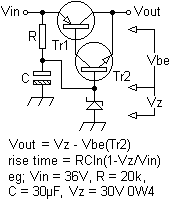
The very informative construction manual suggested other applications, such as a Wien-bridge oscillator, bridge (doubling the output voltage swing) and DC amplifiers.
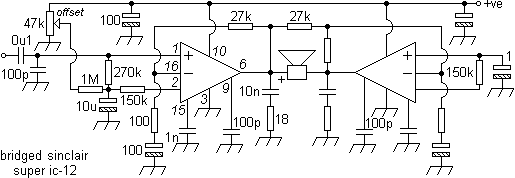
For best results using this configuration; ensure a very low impedance between both IC's earth returns, use 1% resistors in feedback networks (2 x 100R & 3 x 27k, match 100µF caps), select load to draw <1A maximum and set offset pot for minimum voltage across load with input shorted.
The heatsinks from this type of IC could be removed from 'dead' ones and re-used for power transistors. A recent application used them for some class D ICs.
A higher output from a DIL package was offered by the TDA2020 (sourced by C. Rama Murthy)
"which was the first Monolithic mono (1 ch) Hi-Fi amp, 20W into 8 Ohms, in DIP package (staggered pin layout) with integral heatsink tab and was available in 1975 as per the catalogue of SGS ATES (the then Italian company ,which later became STmicro). The THD was very low and the IC could be used both on single and dual supplies. It could also be bridged for higher power. There was also a driver IC available (TDA2020D) which was to drive two power transistors in Push Pull configuration for twice the power. This IC was featured for DIY enthusiasts in Elektor Holland in Feb 1979 and UK in April 1979 and was soon available also in India in the form of kits with heatsinks to facilitate the constructor. I did it in 1980 or 1981.The problem was that with rated voltage, heatsink was needed to keep the IC safe even without load to dissipate the quiscent power. Otherwise ICs were getting hot and failing-the onchip thermal protection was not probably very effective. Maybe SOA limitation was not well understood and kit designers took data sheet values literally?"
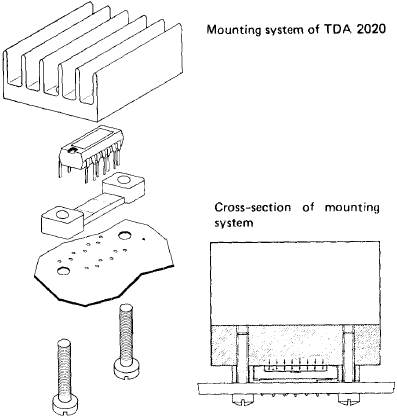
The Elektor article (E 21, Jan '77, p1-42) was followed by mods (E 23, Mar '77, Missing Link, p3-56) recommended by an updated SGS datasheet which included two output clamping diodes, the roll-off capacitor connected to the output instead of pin 10 and advice that the single supply version (output AC coupled) should not be used with loads of less than "8R since the phase shift caused by the capacitor could then cause damage to the IC". Although magazines like Elektor, ETI, PW, PE, etc, were enormously informative it was always an idea to not rush to build a new design, but to wait until revisions were published to accommodate modifications resulting from debugging. Some magazines, obviously, were worse than others, ETI in particular from the author's point of view.
As the technology improved (TBA8**, etc), power ratings increased and safety circuits were included increasing survivability. Sophisticated high current hybrid opamps, like the 1974 RCA HC2000H (current-limited) and low-distortion HC2500 (7A each) series, whose applications included motor control and inverters, could give useful service in audio appications (HC2500 - 60W/4R and 200W/4R bridged). The later ('79) Philips OM931 (30W) and OM961 (60W) were noted for their 'clean' performance.
The 5-pin Pentawatt TO220 TDA series, came a long way (in terms of output power and protection) from DIL types (the more recent TDA2050 giving performance comparable to reasonable discrete designs) and offering an even smaller PCB footprint.
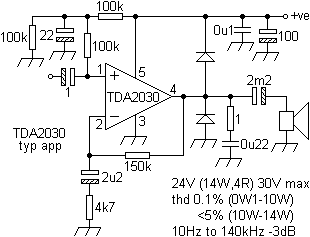
Below is a bridge layout.
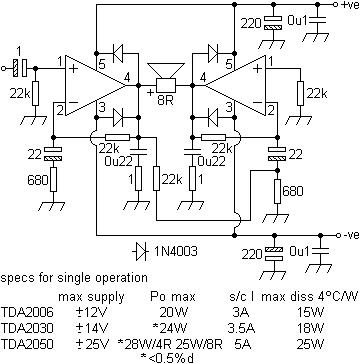
These may not use a centre-tapped mains transformer and additional output pairs can boost the output current, eg;
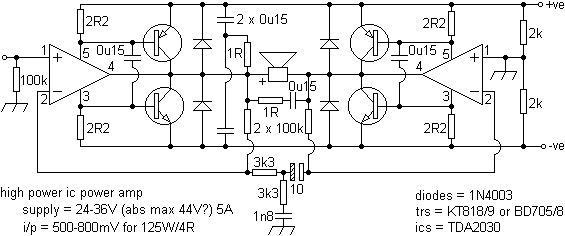
Lower distortion was achievable with the LM1875 (observe PCB layout criteria).
Larger package types, such as the TDA1514 and the DMOS TDA7294, are useful for compact integrated active speaker designs and biamping in multi-channel systems, although slew-rates can vary and output power estimates can appear optimistic. Some published projects quote a 40W output for the LM3876 when it's datasheet gives 56W. The LM3886 can be quoted as 150W, when it's datasheet states 68W.
A compact PCB to fit both the LM3876/86 power amp ICs appeared in Elektor (Dec 95, Jul/Aug 98). Experience has suggested that a reasonable working voltage for types like these, given dissipation and 4-8 ohm loads, is ±30V (Tamb = 50°C, thermal res = <3.5°C) or less (±35V abs max, 18-0-18V transformer max recommended). A small and simple design might then look like that below;
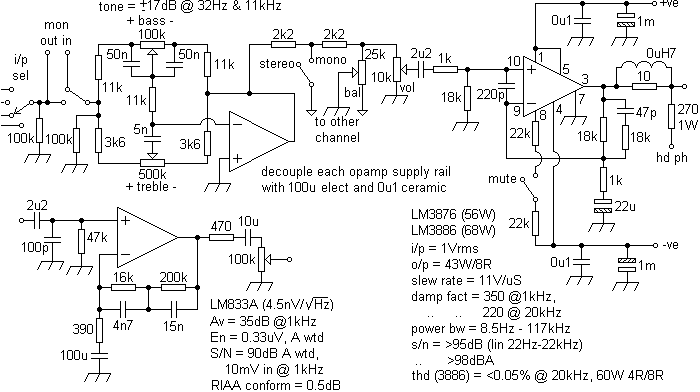
Run PA into 8 ohms for best results (heatsink <3.8°C/W), assuming a safe maximum output of 60Wrms or less. Using dual opamps reduces PCB area and these can be run from zener-stabilised resistive feeds from the supply lines. Include lots of smoothing. Once matched to load, gain of PA may be reduced to give no clipping at all normal control settings with volume at maximum. Removing feedback RC (47pF-18k) will increase slew rate to 16V/µS. Mute can be fed from two diodes and a small electrolytic run from transformer secondary thus activating before main smoothers discharge, eg;
